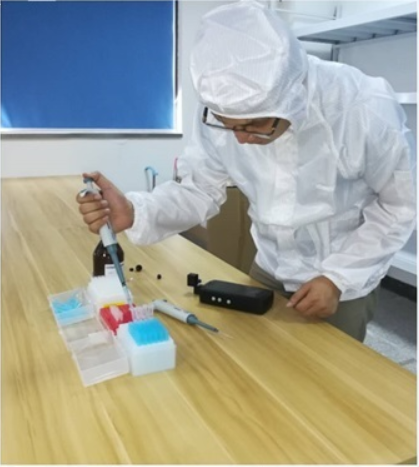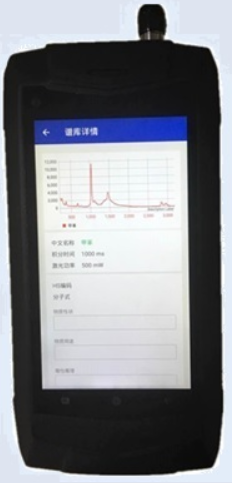| Launch:2019-07-26 |
* Introduction

Rhodamine B, also known as rose B, or alkaline rose essence, commonly known as pink, is a synthetic dye with bright pink. Experiments show that Rhodamine B will cause cancer and is not allowed to be used for food dyeing. But illegal vendors will take advantage of the consumer's willingness to sell, to pepper, chili pepper, red pepper oil, red soybean products and other foods to add rhodamine B to improve its redness.
It has been proved that Rhodamine B can directly endanger human health and has potential carcinogenicity, mutagenicity and cardiotoxicity. It is one of the first food additives listed in the list of non-edible substances that may be added illegally and easily abused in food in 2008. It is severely monitored and cracked down by the regulatory authorities. It is very difficult to distinguish Rhodamine B from the naked eye. The commonly used detection methods are mainly GC and GC-MS.
This detection method requires large instruments and equipment, which is expensive. Raman spectroscopy has been widely applied in many fields such as analytical chemistry. Surface-enhanced Raman (SER) technology has been widely used in food safety and material science because it can provide high sensitivity. In this paper, Raman spectroscopy only needs simple sample pretreatment, can be obtained in 10 minutes whether the food contains illegal addition of Rhodamine B test results.

* Application
Rhodamine B1000ppm (mg/kg), deionized water (secondary distilled water), reinforcing agent, coagulant, acetonitrile, pepper powder, acetonitrile



EVA 3000 Plus, Raman liquid measuring support, ultrasonic extractor, centrifuge (10,000 revolutions), transfer gun (1-1000ul, 1-100ul, 1-200ul specifications)

Handheld Raman spectrometer EVA3000Plus produced by Shanghai Oceanhood Optical Technology Co., Ltd.
Instrument parameters
| Physical parameters | |
| Size | 180*95*38mm |
| Weight | <800g |
| Input interface | Micro USB |
| Performance parameter | |
| Spectral range | 200 cm-1~3200cm-1 |
| Wavelength resolution | 15cm-1 @1000 cm-1 |
| Excitation wavelength | 785±0.5nm,Linewidth< 0.1nm |
| Laser lifetime | 10,000.00hrs |
| Voltage | DC5V Electric adapter |
| output power | 0~500mW self-adaption |
| Integral time | 1ms-10S Self-adaption |
| Probe Rayleigh scattering cut-off depth | OD6 |
| Probe focal length | 7.5mm |
| Camera | 8 million pixels |
| Touch screen | 720*1280 Resolution capacitance screen |
| Three defense standards | IP65 |
| network | 4G/WIFI/Bluetooth/GPS |
| Environmental parameters | |
| Working temperature | 0 ~ 45℃ |
| Working humidity | 5%-80% |
Test standard samples:
Step 1. Take 1 uL of Rhodamine B1000 ppm with a pipette gun, take 999uL of secondary water and configure 1 ppm of Rhodamine B standard sample

Step2, use the pipette to take reagent A (gold size) 500ul to reagent bottle.
Step3, use the pipette to take Luo Danming standard sample 50ul to reagent bottle.
Step4, use the pipette gun to get reagent B (coagulant) 100ul to reagent bottle, shake well.
Step5, test Raman signal, set 200MW laser, integral time 5 seconds.
Precautions: shake well before testing and complete the sample test in 2-3 minutes.
Actual samples tested:
Step1, 1g pepper powder.
Step2, use 50ppm to get rhodamine B100ul.
Step3, use the pipette gun to extract 100ul acetonitrile (get positive sample 5ppm).
Step4, take 3ml acetonitrile, shake well, ultrasonic for 10 minutes, take supernatant 500ul

Step5, take reagent A 100ul, centrifuge centrifuge for 2 minutes, liquid solid separation, take supernatant.

Step6, use the pipette to take reagent A (gold size) 500ul to reagent bottle.
Step7, use the pipette to take reagent samples 50ul to reagent bottle.
Step8, use the pipette gun to get reagent B (coagulant) 100ul to reagent bottle, shake well.
Step9, test Raman signal, set 200MW laser, integral time 5 seconds.

* Result discussion
The surface enhanced Raman spectra of Rhodamine were obtained from the experimental data of 1 ppm standard sample and 5 ppm actual sample. The following image shows the Raman surface-enhanced Raman spectra (spectral smoothing, baseline subtraction, normalized data processing) of the actual and standard pepper samples:

The similarity of Raman surface-enhanced Raman spectra between the actual sample and the standard sample was 0.8868. From the characteristic peak, the characteristic peak of Rhodamine was detected and the positive sample was judged.

上海如海光电科技有限公司400-820-7939
